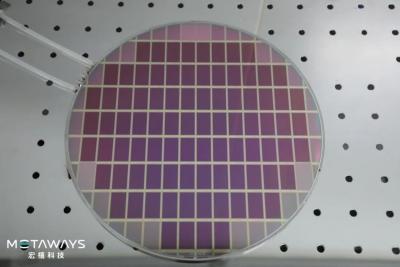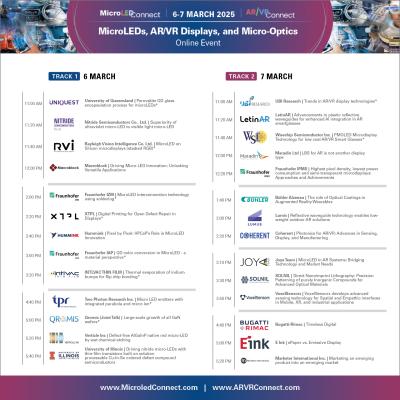OLED Microdisplays: learn more and find a supplier!
OLED is a next-generation display technology that is replacing LCD displays in several markets, such as small displays for mobile applications, TVs and microdisplays. OLEDs are made from thin films of organic light emitting materials that emit light when electricity is applied. OLEDs have a much simpler structure compared to LCDs and have several advantages over the incumbent technology.

OLED microdisplays
OLED microdisplays are considered to be the current state-of-the-art near-eye display technology. OLEDs offer many advantages over competing technologies:
- No backlight - a direct emissive display with high contrast and a wide color gamut
- Fast refresh rate
- Low power consumption (this depends on the image shown)
- Wide operation temperature range
OLEDs do suffer from lower lifetime, limited market capacity, high price. Many believe that microLEDs will offer the ultimate solution for microdisplays, with their inherent high brightness and efficiency, but these displays are not commercial yet.
The OLED Microdisplay industry
Several companies in the US, Europe and Asia are producing OLED microdisplays - including eMagin (acquired by Samsung in 2023), Sony, OLiGHTEK, Kopin, BOE and SeeYa. In addition, Samsung and LG are both gearing up towards OLED microdisplay production.

If you're interested in adopting OLED microdisplays in your device, we'll be happy to help, you can browse available display in our OLED marketplace. Be sure to send us a mail and together we can find the best display for your project.
Learn more about the OLED Microdisplays industry and market
Are you looking for more in-depth information on the OLED Microdisplay industry? Check out our OLED Toolbox, which provides a complete set of information products and tools for OLED professionals. The Toolbox provides an unprecedented depth of OLED content, data, analysis and insights, written and compiled by the industry's leading portal, OLED-Info.com.
The OLED Toolbox includes details on all OLED microdisplay developers and producers, a list of all current and planned fabs, a list of all microdisplays on the market, many company brochures and roadmaps, and more.
Researchers design new hole transport materials and processes to enable the production of 10,000 PPI OLED microdisplays
Researchers from Korea's Hanyang University, Yonsei University, and Sogang University have jointly developed new hole transport materials and processes that enable the fabrication of ultra high definition OLED microdisplays - achieving over 10,000 PPI.
The researchers explain that one of the problems with ultra-high-density OLED displays is that as the distance between pixels approaches the micrometer level, electrical signal interference which leads to light leakage from closeby pixels and a decrease in color fidelity. This leakage between subpixels occurs because the hole transport layer that facilitates the movement of holes is shared among the pixels that form the display.
Metaways raises $68.5 million in its Series A funding round
China-based OLED microdisplay producer Metaways (also called Zhejiang Hongxi Technology) announced that it has successfully completed its Series A funding round, raising almost 500 million Yuan (around $68.5 million USD).
Metaways is building a 12-inch microdisplay production line in Yiwu City, Zhejiang province, and is developing high-end OLED microdisplays, including a 1.4" 4K product.
Join us in March for a 2-day MicroLED and AR/VR innovations virtual event, as part of MicroLED-Connect!
MicroLED Connect, our hybrid event series focusing on the microLED industry, will be hosting a two-day virtual event focused on MicroLED and AR/VR innovations, technologies, manufacturing, markets and more. The online event will take place on March 6-7, and will be an excellent opportunity to learn the latest microLED and AR/VR updates and connect with industry professionals on our excellent online event platform. This event could be highly interesting for OLED display developers and anyone working on microdisplays, AR and VR solutions and more.
Today we have published the agenda for this event, with over 25 exciting talks by leading microLED developers, AR/VR developers, supply chain companies and top-edge researchers. This will be an excellent opportunity to learn and connect with the microLED industry. You can register for the event here, with a yearly pass to MicroLED-Connect (with an option to also include entry into our September on-site event in Eindhoven, The Netherlands). Our members also gain access to past event recordings.
Researchers at the Fraunhofer IPMS developed a 200,000 nits monochrome OLED microdisplay
The Fraunhofer IMPS announced that it has developed an exceptionally bright OLED microdisplay, using a novel stack architecture. The new 0.62" SXGA monochrome (green) microdisplay achieves a brightness of 70,000 nits, and on reference substrates it has even achieved over 200,000 nits.
The new architecture uses a 3-stack architecture, which means that three complete OLED device stacks are placed on top of the other. This achieves high brightness, and also reduces the current density for a given brightness compared to a single stack device - and so enhances the lifetime of the device.
Samsung may convert its 5.5-Gen A2 OLED fab to a microdisplay production line
A few weeks ago it was reported that Apple is aiming to develop a lower-cost VR headset, and will want to use cheaper OLED microdisplays to replace the high-end Sony OLED microdisplays used in the Vision Pro. It was reported that both Samsung and JDI are in talks with Apple, that aims to achieve a pixel density of 1500 PPI (the Sony microdisplays sport 3,400 PPI). Samsung meanwhile develops its own headsets, and is also working on solutions for other leading companies, such as Microsoft.
 A 1.3" 12000 nits OLED microdisplay (Samsung Display)
A 1.3" 12000 nits OLED microdisplay (Samsung Display)
While Samsung is working on an OLED on silicon microdisplay factory, the company is also looking to start producing high resolution AMOLED displays on glass. According to a new report, Samsung is now looking to build a new AMOLED on glass microdisplay pilot production line in Asan, and later on the company is considering to converts its 5.5-Gen (1300x1500 mm) A2 OLED production line to produce OLED microdisplays. Samsung will have to modify its production process and install new equipment to support the high resolution. The company reportedly aims to order the required equipment in 2025.
Sony launches a new 10,000 nits 0.44-inch FHD OLED microdisplay - the world's brightest and with the smallest pixels
Sony announced a new OLED Microdisplay, the ECX350F, a 0.44" 120Hz 1920x1080 (FHD) microdisplay that offers the world's highest brightness at 10,000 nits. It also offers the world's smallest pixel size at 5.1 um (the PPI is around 5,000).
Sony says that in order to reach this high brightness, it adopted a new OLED stack structure, a new "semiconductor process" and added a microlens array on top of the display. In addition, the bezel size of the new display is exceptionally small, with only 1.14 mm of added bezel on the long side of the display on both top and bottom.
Apple looks to adopt a TFT AMOLED for its future entry-level MR headset
There's an interesting report in Korea that claims that Apple is developing an entry-level MR headset, and is looking to adopt TFT based AMOLED displays, as opposed to the currently-used OLED microdisplays. It is reported that both JDI and Samsung are in talks with Apple, and have been requested to develop lower-cost TFT AMOLEDs with a pixel density of 1,500 PPI (down from 3,400 PPI high-end Sony microdisplays used in the Vision Pro).
It is understood that JDI has already developed the technology and produced 1,500 PPI samples for Apple. Interestingly it is reported that the JDI displays uses Sony's technology, although it is not stated which technology exactly. Samsung meanwhile is also developing 1,500 PPI AMOLEDs at its A2 fab. Apple's target is to release the headset at around 2026-2027 and by then it is likely that more OLED producers (such as LG Display) will develop similar displays.
BOE developed 5,000 nits tandem 4K 0.9" OLED microdisplays
During the company's 2024 Innovation Partner Conference, BOE unveiled its latest OLED microdisplay. The display is a 0.9" 4K (6020 PPI) panel, that is based on a tandem OLED architecture. It achieves a maximum brightness of 5,000 nits.
BOE has also unveiled ultra-light (150 grams) VR glasses based on these displays. It is not clear whether this is a product that BOE aims to commercialize, or a reference design, or a product produced by one of its partners.
Meta reportedly cancels its plans to release a high-end VR headset
According to reports, Meta has decided to cancel one of its VR projects that was planned for 2027. This device was to be a high-end product, similar to Apple's Vision Pro - with a similar high price tag. Following the poor market reaction for Apple's Vision Pro, Meta decided to scrap the project.

The original Oculus Rift
Meta was planning to use OLED microdisplays in its upcoming high-end headset, as these are the best performing displays for such products. It is reported that one of the reasons that Meta is not proceeding with its project is the high price of the OLEDs. These are expensive displays indeed - according to some estimates, Apple is paying $350 for each display, which means around $700 for each headset. On the other hand, it is estimated that OLED microdisplay prices are set to drop sharply in the near future as new capacity comes online, and new players (including Samsung and LGD) start producing displays.
Samsung shows a 1.3" 12,000 nits OLED microdisplay at K-Display 2024
Samsung Display demonstrated a new OLED microdisplay at K-Display 2024, a 1.3" 12,000 nits 4000 PPI display. It is not clear whether this display is a direct-emission display, or one that uses white OLEDs with color filters.
Samsung Display's CEO, Choi Joo-seon, said during the conference that SDC will soon commercialize OLED microdisplays based on eMagin's direct-patterning deposition technology (SDC acquired eMagin in 2023). Choi says that the price of OLED microdisplays is an important differentiating factor. Last week Omdia estimated that the price of OLED microdisplays is set to decline sharply in the near future.
Pagination
- Page 1
- Next page









